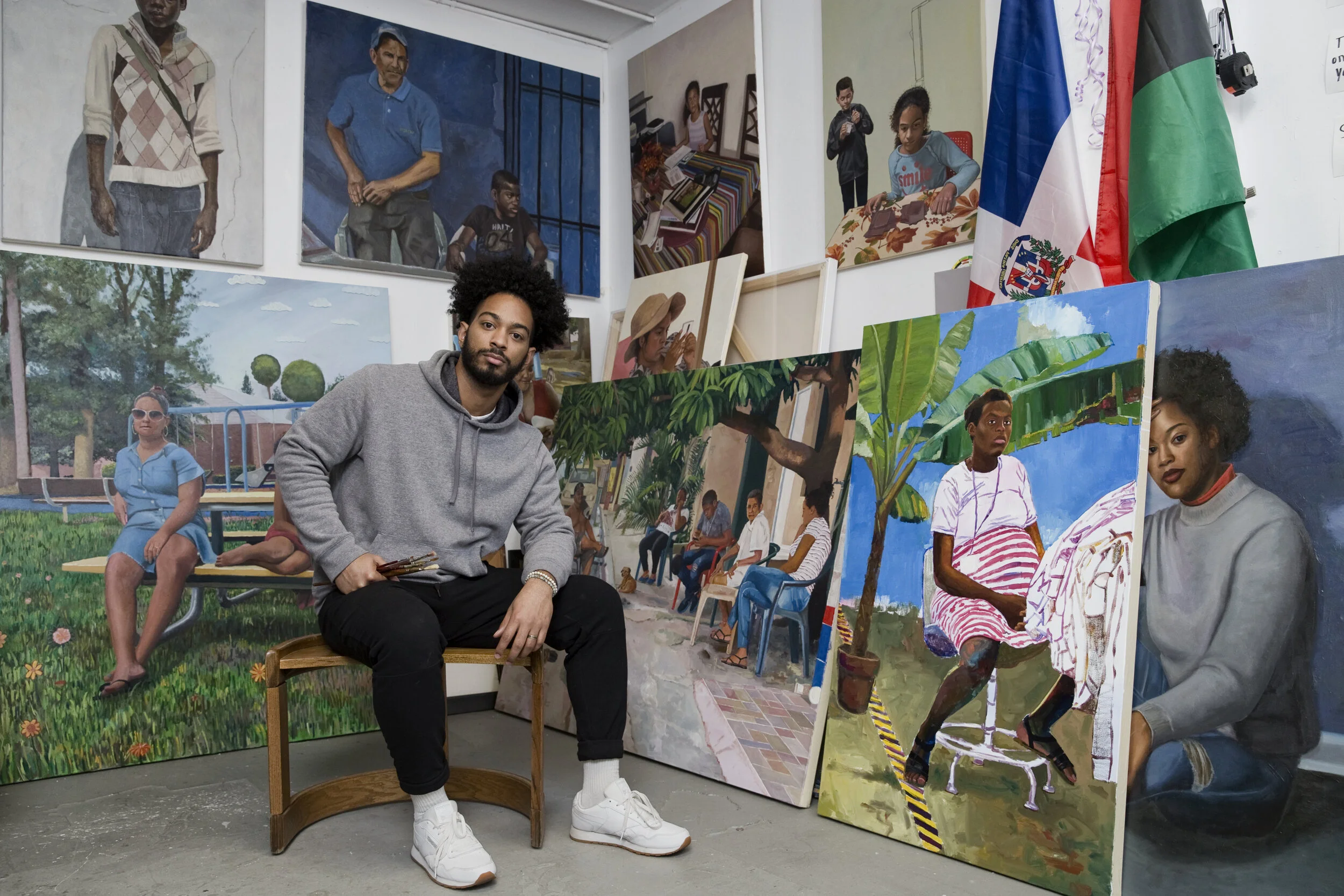Art Convo with Cielo Félix-Hernández: Boricua Artist Displays Femme Island Life Magically on the Canvas
Courtesy of the artist.
A genuine conversation with Cielo Félix-Hernández (they/she), a New York-based, Boricua painter and artist originally from Rio Piedras, Puerto Rico. Hernández’s work is unapologetically luscious, sensual, femme, and carries a deep richness of Caribbeanness. In this intimate interview, she shares the deeper meaning behind platanos in her work, and why a clean space is central to her art practice.
How are you feeling at this moment?
At this present moment, stressed. I’ve been struggling to participate in the world again as things reopen here in NYC. Practicing patience with myself for sure!
What are some self-care rituals that keep you whole?
Caring for my space has a big effect on how I’m caring for myself. Cleaning regularly is a must, but deep cleaning as a form of care? It’s different and it gives me space to begin new projects. I feel like the moment my art practice doesn’t center care I can no longer hold space, it’s gotta be reciprocal, you know? Sometimes with the rapidness of everyday life self-care becomes less of a priority. Subconsciously, i’m reminded of my state of mind when my space is a mess. And in that moment I immediately take action to make sure I’m caring for myself.
“I feel like the moment my art practice doesn’t center care I can no longer hold space, it’s gotta be reciprocal, you know?”
Callate Blanco (chicken monologue), oil on canvas, white satin cord, 2020. Courtesy of the artist.
I love the platano heels in your paintings. Platanos are emblematic of Caribbean life, but you've flipped their context and made them femme and decorative. Can you talk about the presence of platanos (plantains) in your paintings?
Their presence in my paintings began last March. I reflected heavily on the ways platanos have been misconceived and dismissed as just bananas and exotic fruit. When in reality they were so important and emblematic of sustainability to me, culturally and through my experience growing up consuming platanos with like every meal. That misconception, or just lack of understanding of what they were, made me relate so much more to them. I wasn’t sure how i’d begin using them, they started as sculptures in 2018. I started by creating silicone molds of platanos of different sizes/forms, which I would later cast in wax and became a daily ritual. I’d make one a day, and the repetition that exists within this ritual definitely inspired me to commit to platanos as a material. I began adding camphor, eucalyptus, coconut oil, lavender and bay leaves, mixing ingredients that I’ve associated or used for healing/medicinal practices.
The process of physically creating them made me think of hybridity in a new way. There are many overlaps and layers of my identity, the heels are a meeting place for my own ancestral and trans identity. Having objects that are emblematic of that intersection are important. When i painted Limpieza Pura, it was the first appearance of the platano heels, i wanted a form that elevated the figures while also symbolically and psychologically reinforcing dominance within any space they are placed into.
“There are many overlaps and layers of my identity, the heels are a meeting place for my own ancestral and trans identity.”
Limpieza Pura, oil on canvas, satin cord, 2020. Courtesy of the artist.
Your subject matter overflows with Caribbeanness, curvy femme figures, freshly done nails, Santeria references, and island life. What do these elements mean for you on the canvas?
Pretty rare to see them exist on a canvas all at once I feel? All of these elements are what I grew up to understand as “taboo.” I grew up in a very Pentecostal/Catholic household, I was taught to see myself and practice a religion that wasn’t even mine or didn’t even honor me, my family and my ancestors. I said fuck that immediately, “soy Afro-Boricua.” My work will forever reflect and honor that.
I’ve felt a divine connection to the sky, rivers and oceans. That’s all I really needed to ground me in what I now know to be true. My aesthetic choices all stem from the femmes and women I always looked up to growing up, My Titi Sonia has kept her nails in order for decades, and that’s inspiring to me. Maintaining long ass nails is hard, it’s next level care that I associate with a divine power and commitment to self-hood which contains so much value to me. Ivy Queen, the Puerto Rican diva, is definitely a big inspo. I’ve always adored her, she made space for herself in a male-dominated genre and i just loved to see it. I saw myself and learned to embrace my femininity through them in a lot of ways. I try my best to keep everything thick and juicy in honoring change, bodies in transition, and decolonizing beauty standards. I think reclaiming aesthetics lately have been on my mind the most because of how often we see our own aesthetics used, commodified, and appropriated.
What's next for you in 2021?
I’m excited for this year, I have a good feeling about it, I hope i don’t look back at this and laugh for saying that. I’m just trying to manifest a good year. I’m part of a few group shows this year, including the recently opened Visions and Nightmares at Simone Subal Gallery.
Courtesy of the artist.









